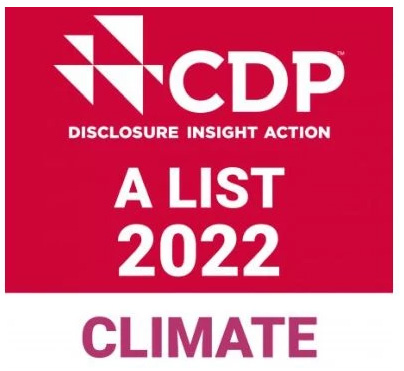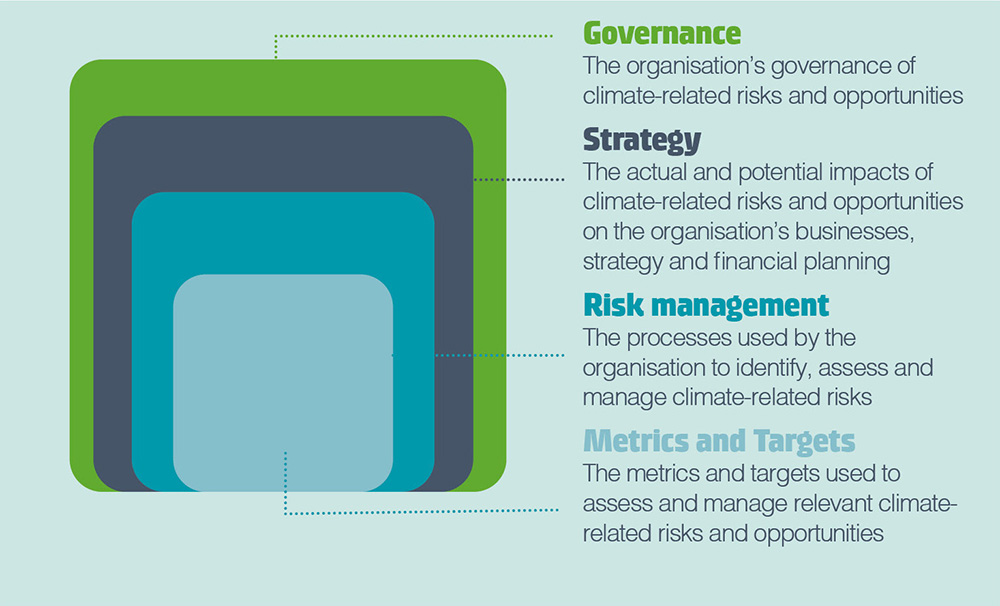In a context of significant changes in the regulatory, economic and industrial sectors, caused by the transition towards a decarbonised economic model, there is growing pressure from investors, public bodies and society for organisations to report transparently on how they manage risks and opportunities arising from climate change in the short, medium and long term.
Within this transitional framework, in December 2015, the Financial Stability Board (FSB) established the Task Force on Climate-related Financial Disclosures (TCFD) to develop climate-related disclosures that “could promote more informed decisions on investment, credit and insurance underwriting” and, in turn, “would allow stakeholders to better understand the concentrations of carbon-related assets in the financial sector and the exposures of the financial system to climate-related risks”. The TCFD frames climate-related information in the business context under four pillars (governance, strategy, risk management, and metrics and objectives) and recommends disclosure in each pillar.
With its firm commitment to climate change and to making GHG emissions one of the focal points in decision-making, Cellnex takes into account the risks and opportunities presented by climate change, incorporating them into the organisation's vision and objectives for the coming years. As such, using four core elements, as recommended by the TCFD, Cellnex shows how it takes account of climate-related risks and opportunities, as well as strategies to mitigate risks and mainstream opportunities.
Cellnex has been a TCFD supporter since 2021, reaffirming its commitment to Climate Change transparency and disclosure.

Climate change mitigation is based on preventing or reducing the emission of greenhouse gases, either through the use of new technologies and renewable energies, such as replacing older equipment with more efficient models. Cellnex undertakes actions focused on mitigating climate change, such as through emission reduction initiatives (Science-based targets, energy efficiency, sustainable mobility, carbon management along the value chain, etc.). Moreover, Cellnex has shown its commitment to a carbon-neutral business model by setting out the Cellnex Net-zero Strategy.
In addition, it is essential to adapt to climate change to ensure the long-term resilience and conservation of Cellnex assets. As such, in 2022 Cellnex developed a Climate Change Adaptation Plan. The main objective of the Cellnex Climate Change Adaptation Plan (CCAP) is to prevent or reduce present and future damage from climate change.
With sites across Europe, Cellnex must address climate variability on a regionalised basis, so there is a particular need for a Plan that takes an integrated approach to the potential consequences of climate variability, both globally and regionally, and the vulnerability of asset types to climate conditions based on their geolocation. For this reason, the CCAP makes it possible to:
The project has two separate parts:
Two periods were analysed under a RCP 8.5 scenario: 2011-2040 and 2041-2070. In the period 2011-2040 only 2.19% of assets are subject to critical or high physical climate risk. The distribution of risks follows a normalised distribution that places the largest set of assets at low risk (49.23%). In the period 2041-2070 the percentage of assets at high or critical risk increases to 10.56%.
The variables analysed were: temperature, precipitation, wind, storm surge, sea level rise, flooding, fires and landslides. The climatic variable that primarily affects all assets at both horizons is temperature.


For the fourth year in a row, Cellnex has been recognised for its transparency and commitment in tackling climate change on the prestigious ‘A List’ compiled by CDP, the non-profit administrator of a global disclosure system allowing investors, companies, cities, states and regions to manage their impact on the environment. In 2022 Cellnex excelled in "exhaustive disclosure, awareness and management of environmental risks and demonstrated best practices in environmental leadership, such as by setting ambitious and meaningful targets."
Climate risk and opportunity analysis at Cellnex Telecom forms part of the risk management process, following a bottom-up methodology, from every user in every business unit to senior management. To this end, it has a Global Risk Management Policy, establishing a framework that implements, evaluates and improves risk management throughout Cellnex Telecom's processes and activities.
Cellnex's governance of climate-related risks and opportunities and the risk management lifecycle ensures the overall and appropriate management of risks in the organisation; through the various levels of monitoring and validation, providing meaningful reporting to the Board of Directors.
The climate risk analysis takes into account the time horizon analysis (short/medium/long term), the financial magnitude and management costs and the analysis of climate scenarios:
Physical scenarios: An RCP scenario is analysed, cumulatively measuring human emissions from all GHG sources to 2100. It is more relevant to take the worst case scenario into consideration, so the RCP 8.5 scenario was selected to analyse the climate projections. RCP 8.5 shows a Business-as-Usual (BaU) scenario, in which GHG emissions would continue to increase at the current rate. This is a worst-case scenario of higher GHG emissions in the atmosphere and further global warming.
Transition scenarios: two scenarios were selected: Stated Policies Scenario (SPS), with the objective of looking at the existing trajectory and seeing what future risks and opportunities would result from not implementing measures, and Sustainable Development Scenario (SDS), a scenario that goes beyond the policies currently in place. It is considered a more ambitious scenario of reductions than the Paris Agreement, i.e. one in which global warming is kept below 2°C.
As regards the resilience of the strategy, the results obtained from the analysis allow us to anticipate potential impacts and to inform and influence our strategy and business objectives. Thanks to the risk management that has been in place for years and this latest update in terms of policy, management and governance, Cellnex Telecom has further increased its resilience and will have the necessary tools to deal with potential future climate risks.
As such, in 2022 Cellnex worked on updating the management and evaluation of risks and opportunities arising from climate change. For this evaluation, the risks and opportunities are prioritised as high, medium and low, taking into account two aspects: impact and probability. As a result of this process, in 2022 Cellnex identified and evaluated seven climate risks and seven climate opportunities. Those with the highest priority are outlined below:
|
Risk |
Type |
Time framework |
Magnitude |
|
GHG emissions price increase |
Transitional, Legal and policy |
Medium term |
Medium-High |
|
Regulatory obligations arising from F-Gas reduction |
Transitional. Legal and policy |
Medium term |
Medium |
|
Increased average temperature |
Physical Chronic |
Long term |
Medium |
|
Opportunity |
Type |
Time framework |
Magnitude |
|
Use of more efficient production and distribution processes |
Resource efficiency |
Short term |
Medium-High |
|
Development of low-carbon goods and services |
Products and services |
Short term |
High |
|
Change in investor preferences |
Products and services |
Medium term |
Medium |

The most appropriate risk management is determined on the basis of an assessment of inherent risk and residual risk, taking into account the strategy, policies, procedures and rules established to cover the risks, identification of the persons responsible, the organisational structure for role definition and the information available to monitor the development of the activity within the parameters (performance, information and communication, etc.).
With this information on the table, a risk response or action plan is created, management undertakes to establish actions to attempt to reduce the level of risk until the risk is controlled and the second line of defence takes action to validate the effectiveness of the action plan.
The targets set by Cellnex Telecom show its stakeholders that it is committed to reducing environmental impact while reducing carbon price exposure. The commitment through the Science-based Targets and the longer term net-zero target involve a combination of approaches including reducing Greenhouse Gas (GHG) emissions, migrating energy procurement in favour of renewable and clean energy and engaging with the supply chain.
Cellnex will continue to measure and disclose its performance in relation to these objectives. Below is an overview of the most relevant climate-related metrics and targets:
Further information is available in the 2022 Environment and Climate Change Report.
Uso de cookies
Utilizamos cookies propias y de terceros para analizar nuestros servicios y mostrarle publicidad relacionada con sus preferencias. Pulsando “Configurar” puede seleccionar las cookies que se instalarán en su dispositivo. Pulsando “Aceptar” consiente su instalación y el uso de todas las cookies que utilizamos. Puede obtener más información aquí.
ACEPTAR COOKIES Configuración de cookies